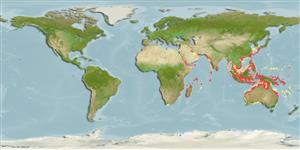Common names from other countries
>
Carangiformes (Jacks) >
Carangidae (Jacks and pompanos) > Caranginae
Etymology: Caranx: French, carangue, the name of a Caribbean fish; 1836 (Ref. 45335).
Environment: milieu / climate zone / depth range / distribution range
Ecologia
marino; salmastro associati a barriera corallina; non migratori. Tropical; 34°N - 39°S, 19°E - 168°E
Indo-West Pacific: East Africa and Madagascar to Fiji, north to the Ryukyu Islands, south to northern Australia.
Length at first maturity / Size / Peso / Age
Maturity: Lm 50.0 range ? - ? cm
Max length : 88.0 cm TL maschio/sesso non determinato; (Ref. 90102); common length : 30.0 cm TL maschio/sesso non determinato; (Ref. 5450); peso massimo pubblicato: 12.5 kg (Ref. 11228)
Spine dorsali (totale) : 9; Raggi dorsali molli (totale) : 19 - 21; Spine anali: 3; Raggi anali molli: 15 - 17. Dark bronze to yellow-green dorsally, shading to silvery bronze to yellowish or yellow green ventrally (Ref. 48635, 90102), yellow to dusky caudal fin and usually outer half of upper caudal lobe black (especially in juvenile) (Ref. 90102). Identified by black-tipped caudal fin (Ref. 48635). Body oblong and compressed, dorsal profile strongly convex to second dorsal fin, ventral profile slightly convex. Breast scalation variable, completely scaly (uncommon) to scaleless ventrally (Ref. 90102). LL with 30-40 strong scutes (Ref. 48635, 90102). Adipose eyelid moderately developed, small anteriorly and extending forward to rear edge of pupil o posterior part of eye. (Ref. 90102)
Adults inhabit clear coastal waters, over rocky reefs in small aggregations (Ref. 5213). Seldom found in turbid or estuarine waters. May be found solitary (Ref. 90102). They feed on fishes and crustaceans (Ref. 5213). Sold fresh and dried salted in markets. Excellent food fish if cooked properly (Ref. 12484).
Life cycle and mating behavior
Maturities | Riproduzione | Spawnings | Egg(s) | Fecundities | Larve
Fricke, R., 1999. Fishes of the Mascarene Islands (Réunion, Mauritius, Rodriguez): an annotated checklist, with descriptions of new species. Koeltz Scientific Books, Koenigstein, Theses Zoologicae, Vol. 31:759 p. (Ref. 33390)
IUCN Red List Status (Ref. 130435)
CITES (Ref. 128078)
Not Evaluated
Threat to humans
Harmless
Human uses
Pesca: scarso interesse commerciale; Pesce da pesca sportiva: si
Strumenti
Special reports
Download XML
Fonti Internet
Estimates based on models
Preferred temperature (Ref.
115969): 23.9 - 29, mean 27.9 (based on 1214 cells).
Phylogenetic diversity index (Ref.
82804): PD
50 = 0.5000 [Uniqueness, from 0.5 = low to 2.0 = high].
Bayesian length-weight: a=0.02089 (0.01183 - 0.03689), b=2.94 (2.80 - 3.08), in cm Total Length, based on LWR estimates for this species & Genus-body shape (Ref.
93245).
Trophic level (Ref.
69278): 4.0 ±0.57 se; based on food items.
Resilienza (Ref.
120179): Medio, tempo minimo di raddoppiamento della popolazione 1.4 - 4.4 anni (Preliminary K or Fecundity.).
Fishing Vulnerability (Ref.
59153): High vulnerability (55 of 100).
